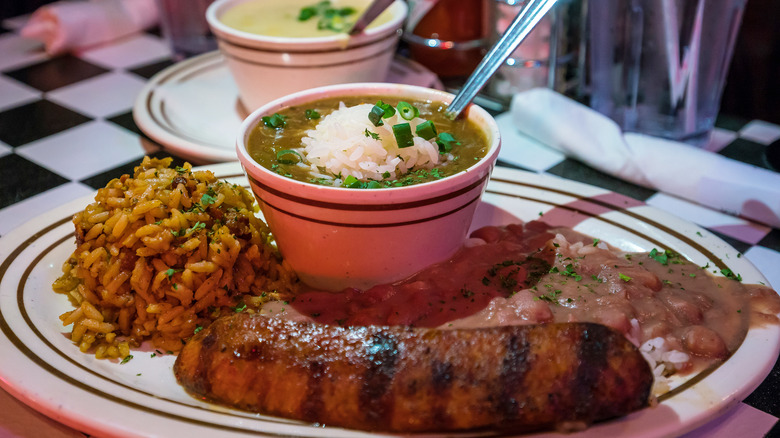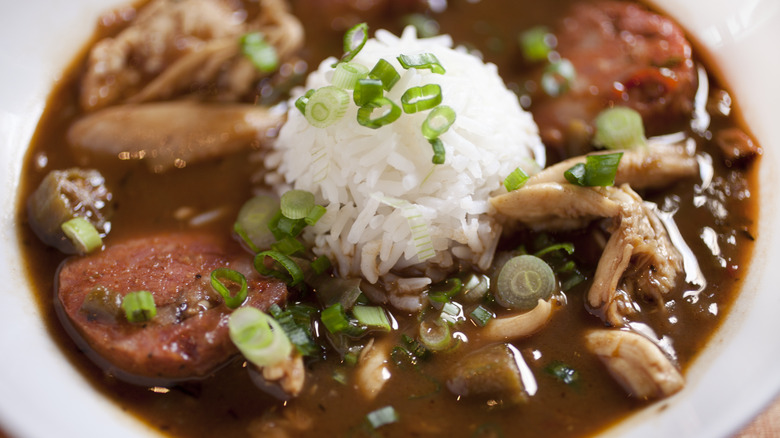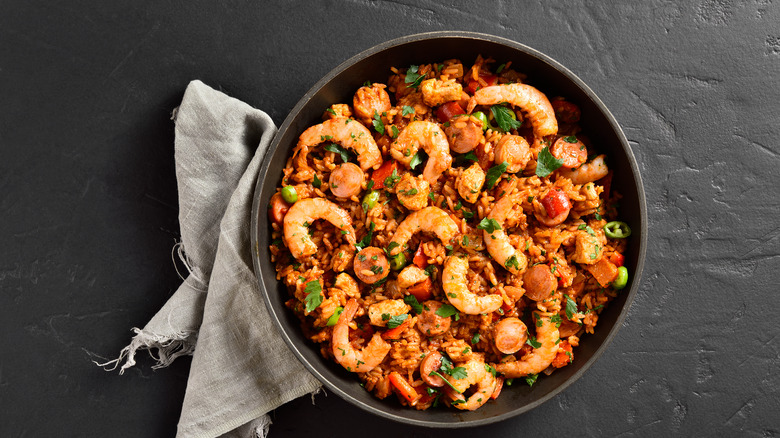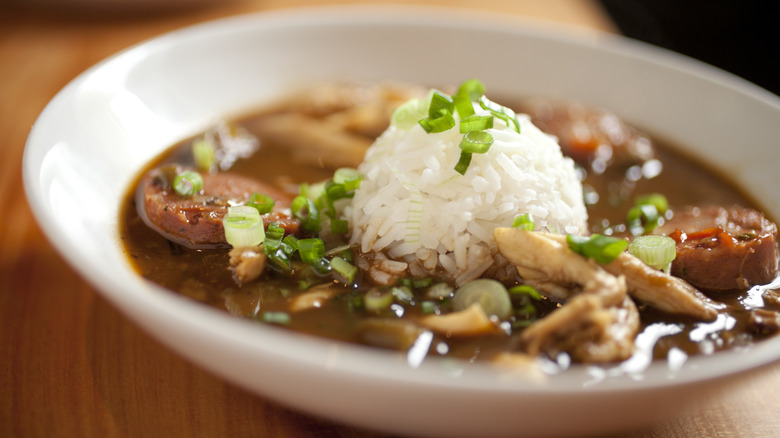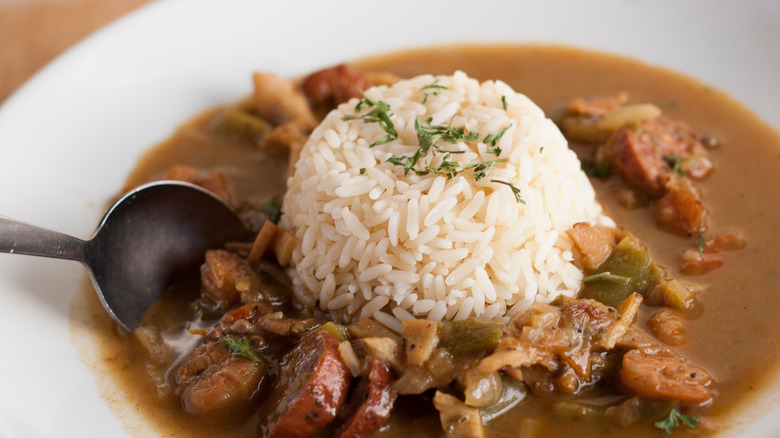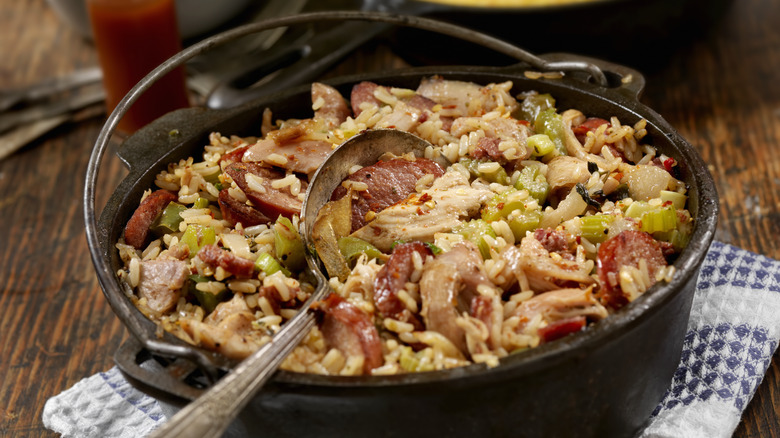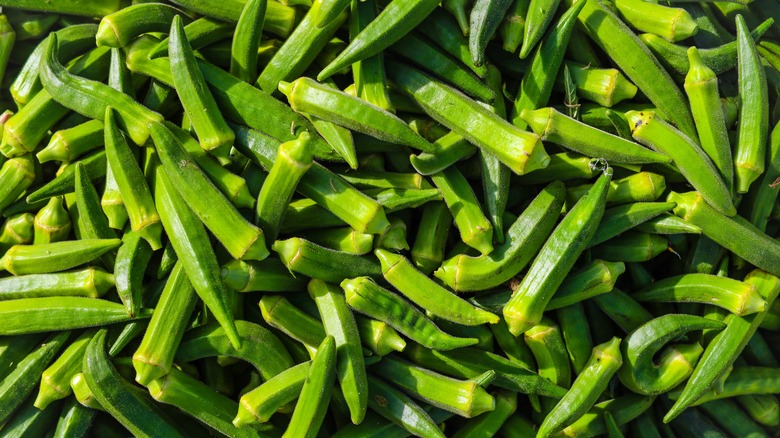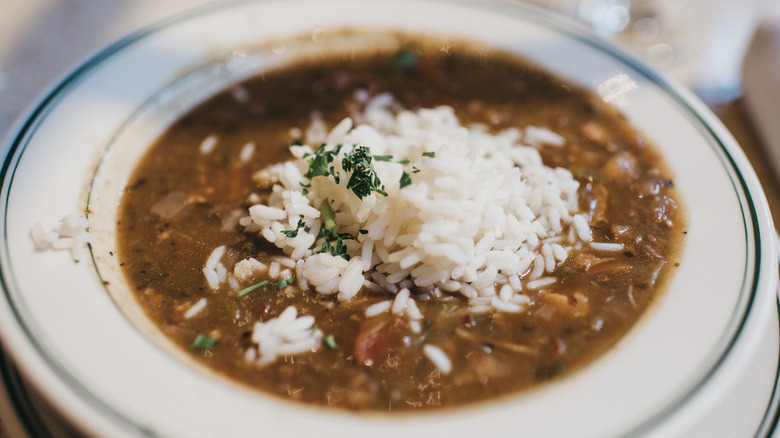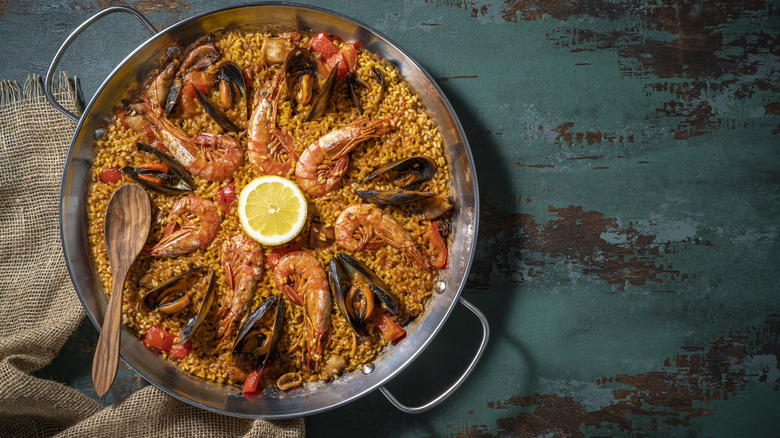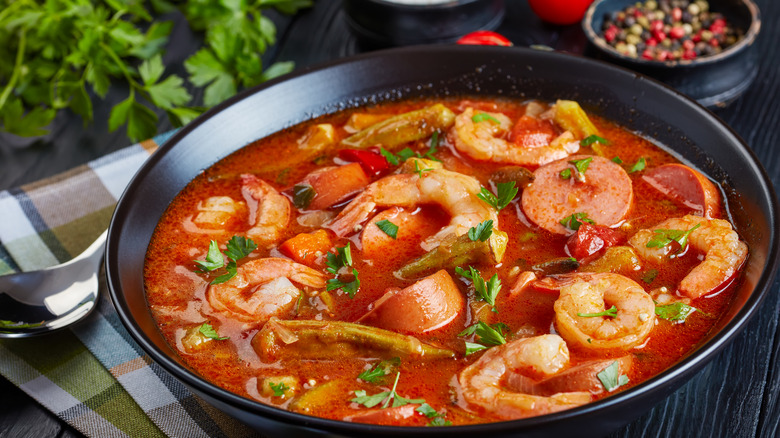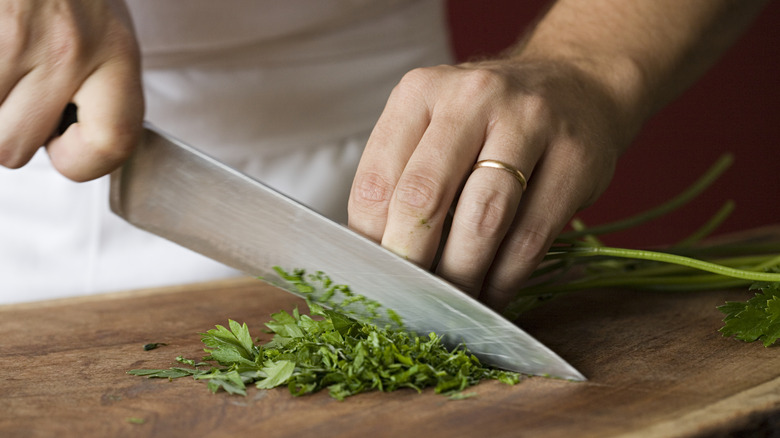Gumbo Vs Jambalaya: Everything You Need To Know
Louisiana's culinary richness may be unparalleled in the U.S., with recipes ranging from cornmeal-crusted fried crab cakes to oyster-stuffed po'boys to ethereal beignets ... and that's just the beginning. But the award for most iconic food may well be a tie between dishes so good they've even inspired music: gumbo and jambalaya.
Gumbo and jambalaya do share a certain number of similarities. Both cannot exist without rice, and both come in both Cajun and Creole versions. Both can easily be changed up by varying the protein, with iterations featuring everything from crawfish to squirrel. But the reality is that for as much as both dishes are synonymous with Louisiana, they're quite distinct, from texture to flavor to even history.
If you're curious about the Cajun and Creole flavors of Louisiana, you've come to the right place. Here's everything you didn't even know you didn't know about these two phenomenal dishes.
What is gumbo?
Rachael Ray called them stewps (stoups?) but the original stew-soup hybrid may well have been gumbo. This dish is a true melting pot of culinary influences from African, American Indian, and European origins, with a thick, aromatic gravy lovingly caressing all manner of ingredients that can range from meat to fish and seafood to vegetables.
Gumbo may have a lot of variety, but it usually begins in the same way: with a roux. This French technique of frying flour in fat often forms the main thickening agent of a gumbo. For this dish, the roux is often cooked until it's quite brown, which lends loads of rich flavor to the resulting dish. The base is further flavored with aromatics like the Holy Trinity of Creole cuisine — onions, celery, and green peppers — before additional ingredients are added. Many gumbo recipes also rely on other thickeners, such as filé powder, okra, or both, to add even more texture to the finished dish, though some are thickened with a roux alone.
What is jambalaya?
Jambalaya, much like gumbo, takes its inspiration from various world cuisines ranging from African to European and Native American to Caribbean. It begins with a similar flavor profile to gumbo, starting with aromatics like onions, celery, garlic, and bell pepper. The fat of andouille sausage is often rendered to help enrich the base and add a lovely smokiness to the finished dish. To this base, meat, seafood, or both can be added, but the main ingredient — the one that makes it a jambalaya — is rice. The resulting dish is far less soupy than gumbo, with the rice absorbing all of the aromatics and juices to become extremely flavorful.
The earliest known jambalaya recipe dates to 1885, but it's entirely possible jambalaya has been around for way longer than that. Since 1968, the dish has been celebrated with a festival every May in Gonzales, Louisiana, aka the Jambalaya Capital of the World. Each year, cooks compete to be crowned World Jambalaya Cooking Champion and fans of the dish come from all over the state to enjoy a variety of events ranging from a beauty pageant to bike races to golf tournaments ... and, of course, to dig into the delicious dish.
Gumbo is the state dish of Louisiana
While fans of jambalaya may not be keen to give gumbo the local culinary crown, gumbo has indeed boasted the distinction of being the official state dish of Louisiana since 2004. First referenced as early as the turn of the 19th century, gumbo's first headlining event may well have been in 1803, when it was served at a New Orleans gubernatorial reception. The earliest documentation of gumbo in rural Cajun country dates to 1804, when it was served at a party. Gumbo unites the urban and rural regions of Louisiana.
Gumbo has also inspired no shortage of festivals in its honor. The World Championship Gumbo Cookoff takes place each October in New Iberia, Louisiana. Each year since 1989, dozens of teams compete over the course of two days to see who will take the crown of this contest, also sometimes referred to as the Superbowl of Gumbo.
Cajun vs Creole gumbo
Louisiana cuisine is a true melting pot, though there are two main culinary traditions: Creole and Cajun. And while there is some overlap between them, there are also a few big differences.
Cajun cuisine takes its roots from the subsistence cooking of Acadians who resettled in rural Louisiana after being forced from what is now Nova Scotia, Canada. They were forced by their circumstances to make the most of what they had. Creole cuisine, meanwhile, derives from the cuisine of French and Spanish settlers to New Orleans, many of whom were wealthier.
While there are many similarities between the two cuisines today, Cajun food tends to be bolder and spicier than Creole food. Creole dishes often feature ingredients like tomatoes, oysters, and shrimp, while Cajun cuisine tends to take advantage of ingredients like pork and crawfish.
While some claim gumbo is originally a Creole dish, others claim it's a Cajun adaptation of an African dish. Still others pinpoint its origins to the West Indies. These days, both Creole and Cajun versions exist, with the major differences between them being linked, firstly, to the type of fat used (Creole roux typically begins with butter, while Cajun versions start with oil or lard). There's also a difference regarding whether or not to use tomatoes; Creole gumbos use them and Cajun versions don't.
Cajun vs Creole jambalaya
Many sources indicate that jambalaya originally hails from Cajun communities, and that makes sense. This one-pot meal would have been invented by families so poor they often only had one pot, with rice stretching whatever meat they had on hand. That said, other sources say the Creole population is responsible for the rise of jambalaya, which tracks with its purported Spanish or French roots. Today, jambalaya exists in both Cajun and Creole forms.
The Creole version of jambalaya hails from the region in and around New Orleans. It's typically made with an onion, pepper, and celery base enriched with tomatoes, which sometimes leads it to be called "red jambalaya." It's also more likely to use shrimp than the Cajun iteration of the dish.
Cajun jambalaya, meanwhile, hails from rural Louisiana. It gets its deep, rusty color not from tomatoes but from meat being caramelized in the pan before the vegetables, stock, and rice are added. It may be made according to the "dumping" method, whereby all of the ingredients are added at once, instead of the method used in Creole cuisine, where each ingredient is cooked separately before being layered together.
Gumbo starts with a roux and is thickened with filé or okra
Gumbo is a thick, hearty stew, typically relying on not one but two thickeners to help give it its silky texture. Roux is a French sauce base made by cooking equal parts of flour and fat together. Often, roux is cooked briefly, giving it a blond color and a barely toasted flavor that makes it perfect for sauces like béchamel and mornay. But often with a gumbo, especially in Cajun communities, the roux is cooked until it's rich and rust-colored, lending a toasty flavor to the soup itself.
Gumbo is also thickened a second way, with okra, its namesake (gumbo is, after all, a Bantu word for okra). Okra is naturally rich in mucilage, a gel-like substance that gives okra its slimy reputation. But this mucilage is a wonderful thickening agent, helping gumbos become even richer and fuller in body and texture.
Rather than using okra as a thickener, some gumbo recipes rely instead on filé or gumbo filé, a powder made from sassafras tree leaves. This is a Choctaw contribution to the classic recipe. These days, you'll find gumbos using one, two, or all three thickeners for an even more luscious texture.
Gumbo is served with rice on top, while jambalaya includes the rice
Rice is a staple of many Louisiana households, particularly in Cajun country, so it's no surprise it's a cornerstone of both gumbo and jambalaya. These days, gumbo is almost always served with rice (though in the early 19th century, cornmeal mush was a popular accompaniment). When it comes to jambalaya, however, rice isn't a side dish but rather the very base of the recipe, soaking up all of the flavors of the meat, aromatics, and spices. In the case of a Creole gumbo, tomatoes are also added, lending the rice a lovely rust-colored hue and even more umami flavor.
Intriguingly, Cajuns often eat their gumbo with another starch in addition to rice: potato salad. It's a matter of debate whether the potato salad belongs on a separate dish or whether it should be scooped onto the gumbo and rice.
Jambalaya may have roots in paella or jollof rice
Given the varied roots of Louisiana cuisine and the similarities between jambalaya and other dishes, some have posited that it may in fact be a local adaptation of a foreign rice-based recipe.
One theory claims that jambalaya may have been created when Spanish settlers to New Orleans tried to cobble together a version of paella. Seeing as they didn't have saffron on hand, these theories posit, the settlers relied on tomatoes to lend a similar color to the dish. Others think jambalaya may be a local calque of West African jollof rice, a dish with even more regional variety than jambalaya. Still another theory looks not at the ingredients of the dish but rather its name, claiming that jambalaya may be French in origin, linked to the Provençal word jambalaia, which loosely translates to a mishmash — and jambalaya is certainly a delicious mishmash.
The presence of tomatoes in either dish is a point of contention
While there's no shortage of debate about both jambalaya and gumbo recipes. Perhaps the biggest sticking point for both is the use of tomatoes. Gumbo and jambalaya can feature them, depending on the cook — but in both cases, there are fairly vocal folks claiming that to do so is heresy.
Tomato-based jambalaya and tomato-based gumbo are Creole creations. The former, also known as red jambalaya, often features shrimp and ham, as opposed to Cajun brown jambalayas, which get their color from slowly caramelizing meat like sausage or giblets before adding the rice.
Creole cooks also often add tomatoes to their gumbos. In contrast, fans of the Cajun iteration say that the rust-colored roux should form both the base of flavor and color for the soup and that tomatoes should be saved for Italian food. Ultimately, if you don't have a stake in the Cajun vs Creole debate, these dishes taste great with or without tomatoes — it's just a matter of preference.
Both often feature meat, but vegetarian versions exist
Meat is often a cornerstone of both gumbo and jambalaya, both of which frequently rely on the smoky flavor of andouille sausage or the lovely brininess of local seafood to form a base. But there are some more veggie-focused iterations of both.
Gumbo z'herbes is a classic gumbo made with different types of greens traditionally served at Lent. It bears mentioning that not all iterations of this verdant gumbo are actually vegetarian. Although veggies form the backbone of the dish, it's often flavored with meat — sometimes, several types of meat. You could also change it up and add black-eyed peas or corn to the base if you want vegetarian additions.
While vegetarian versions of jambalaya may not be as traditional, plant-based recipe developers have indeed crafted versions of the classic dish using tofu sausage as a meat substitute plus loads of seasonings, including soy sauce, to get the umami you crave.
